Effect of Heat Treatment on the As-Cast Microstructure and Hardness of NiSi3B2 Alloy
Abstract
1. Introduction
2. Materials and Methods
3. Results and Discussion
3.1. Characterization of the Solidification Phases of the NiSi3B2 Alloy
3.2. Influence of the Solution Heat Treatment Parameters on the Microstructure of the NiSi3B2 Alloy
4. Conclusions
- The microstructure of the as-cast NiSi3B2 alloy consists of nickel-rich austenite (Ni-γ) with coarse particles of borides (Ni3B) and a large volume fraction of eutectic constituent (Ni-γ-Ni3Si).
- The microstructure can be modified by solution heat treatment (at 930 °C or 980 °C), resulting in the dissolution of the eutectic constituent, with faster dissolution kinetics at 980 °C.
- The dissolution of the eutectic phases is accompanied by solid solution hardening of the austenite.
- The volume fraction of the nickel borides of 42 ± 3% is similar to that of the as-cast condition (42 ± 2%), indicating that the solution heat treatment does not promote the dissolution of borides at the temperatures tested.
- The solutionized microstructure is significantly more homogeneous and the bulk hardness decreases considerably, approximately 17% (from 396 HV to 329 HV and 328 HV after 3 h at 930 °C and 980 °C, respectively).
Author Contributions
Funding
Institutional Review Board Statement
Informed Consent Statement
Data Availability Statement
Acknowledgments
Conflicts of Interest
References
- Davis, J.R. ASM Specialty Handbook-Nickel, Cobalt, and Their Alloys; ASM International: Geauga County, OH, USA, 2000. [Google Scholar]
- Jalilian, F.; Jahazi, M.; Drew, R.A.L. Microstructural evolution during transient liquid phase bonding of Inconel 617 using Ni–Si–B filler metal. Mater. Sci. Eng. A 2006, 423, 269–281. [Google Scholar] [CrossRef]
- Manns, P.; Döll, W.; Kleer, G. Glass in contact with mould materials for container production. Glas. Ber. Glass Sci. Technol. 1995, 68, 389–399. [Google Scholar]
- He, L.Z.; Zheng, Q.; Sun, X.F.; Guan, H.R.; Hu, Z.Q.; Tieu, A.K.; Lu, C.; Zhu, H.T. Effect of carbides on the creep properties of a Ni-base superalloy M963. Mater. Sci. Eng. A 2005, 397, 297–304. [Google Scholar] [CrossRef]
- Shulga, A.V. Boron and carbon behavior in the cast Ni-base superalloy EP962. J. Alloys Compd. 2007, 436, 155–160. [Google Scholar] [CrossRef]
- Cape, A.T.; Calif, M. Nickel-Silicon-Boron Alloys. U.S. Patent 2743177A, 24 April 1956. [Google Scholar]
- Kornienko, E.; Nikulina, A.; Belousova, N.; Lazurenko, D.; Ivashutenko, A.; Kuz’min, V. Structural features of Ni-Cr-Si-B materials obtained by different technologies. IOP Conf. Ser: Mater. Sci. Eng. 2016, 156, 012020. [Google Scholar] [CrossRef]
- Ahmed, M.A.; Hashim, F.A.; Al-Mohaisen, A.M.N. Microstructure and phase analysis of brazing bonds for stainless steel (AISI 316L and 431) to carbon steel (A516 G70) using a Ni–Si–B filler metal alloy. Mater. Sci. Eng. 2020, 881. [Google Scholar] [CrossRef]
- Liu, Y.; Xu, T.; Liu, Y.; Gao, Y.; Di, C. Wear and heat shock resistance of Ni-WC coating on mould copper plate fabricated by laser. J. Mater. Res. Technol. 2020, 9, 8283–8288. [Google Scholar] [CrossRef]
- Tanigawa, D.; Abe, N.; Tsukamoto, M.; Hayashi, Y.; Yamazaki, H.; Tatsumi, Y.; Yoneyama, M. The effect of particle size on the heat affected zone during laser cladding of Ni–Cr–Si–B alloy on C45 carbon steel. Opt. Lasers Eng. 2018, 101, 23–27. [Google Scholar] [CrossRef]
- Chang, Z.; Wang, W.; Ge, Y.; Zhou, J.; Cui, Z. Microstructure and mechanical properties of Ni-Cr-Si-B-Fe composite coating fabricated through laser additive manufacturing. J. Alloys Compd. 2018, 747, 401–407. [Google Scholar] [CrossRef]
- Rakoczy, Ł.; Cygan, R. Analysis of temperature distribution in shell mould during thin-wall superalloy casting and its effect on the resultant microstructure. Arch. Civ. Mech. Eng. 2018, 18, 1441–1450. [Google Scholar] [CrossRef]
- Ajao, J.; Hamar-Thibault, S. Influence of additions on the solidification behaviour of Ni-B alloys—crystallography of Ni-Ni3B eutectic. J. Mater. Sci. 1988, 23, 1112–1125. [Google Scholar] [CrossRef]
- Fraga-Chávez, K.L.; Castro-Román, M.J.; Herrera-Trejo, M.; Ramírez-Vidaurri, L.E.; Aguilera-Luna, I. Phase Selection during Solidification of Ni-10.95 at. % and B-3.23 at. % Si Alloy. Metals 2017, 6, 187. [Google Scholar] [CrossRef]
- Xu, J.; Liu, F.; Zhang, D. Phase selection of undercooled solidification of Ni–4.5 wt% B alloy. J. Mater. Res. 2013, 28, 3347–3354. [Google Scholar] [CrossRef]
- Zhu, C.L.; Wang, Q.; Wang, Y.M.; Qiang, J.B.; Dong, C. Ni-based B–Fe–Ni–Si–Ta bulk metallic glasses designed using cluster line, minor alloying, and element substitutions. Intermetallics 2010, 18, 791–795. [Google Scholar] [CrossRef]
- Siredey-Schwaller, N.; Hamel-Akré, J.; Peltier, L.; Hazotte, A.; Bocher, P. Solidification sequence of Ni-Si-Cr 3wt% B brazing alloys. Weld. World 2017, 61, 1253–1265. [Google Scholar] [CrossRef]
- Thellaputta, G.R.; Chandra, P.S.; Rao, C.S.P. Machinability of Nickel Based Superalloys: A Review. Mater. Today Proc. 2017, 4, 3712–3721. [Google Scholar] [CrossRef]
- Mukhopadhyay, A.; Barman, T.K.; Sahoo, P. Effect of Heat Treatment on the Characteristics of Electroless Ni-B, Ni-B-W and Ni-B-Mo Coatings. Mater. Today Proc. 2018, 5, 3306–3315. [Google Scholar] [CrossRef]
- Hamid, Z.A.; Hassan, H.B.; Attyia, A.M. Influence of deposition temperature and heat treatment on the performance of electroless Ni–B films. Surf. Coat. Technol. 2010, 205, 2348–2354. [Google Scholar] [CrossRef]
- Diabb, J.; Juárez-Hernandez, A.; Colas, R.; Castillo, A.G.; García-Sanchez, E.; Hernandez-Rodriguez, M.A.L. Boron influence on wear resistance in nickel-based alloys. Wear 2009, 267, 550–555. [Google Scholar] [CrossRef]
- de Sousa, J.M.S.; Ratusznei, F.; Pereira, M.; de Medeiros Castro, R.; Curi, E.I.M. Abrasion resistance of Ni-Cr-B-Si coating deposited by laser cladding process. Tribol. Int. 2020, 143, 106002. [Google Scholar] [CrossRef]
- Moreau, E.D.; Corbin, S.F. Application of Diffusion Path Analysis to Understand the Mechanisms of Transient Liquid-Phase Bonding in the Ni-Si-B System. Metall. Mater. Trans. A 2019. [Google Scholar] [CrossRef]
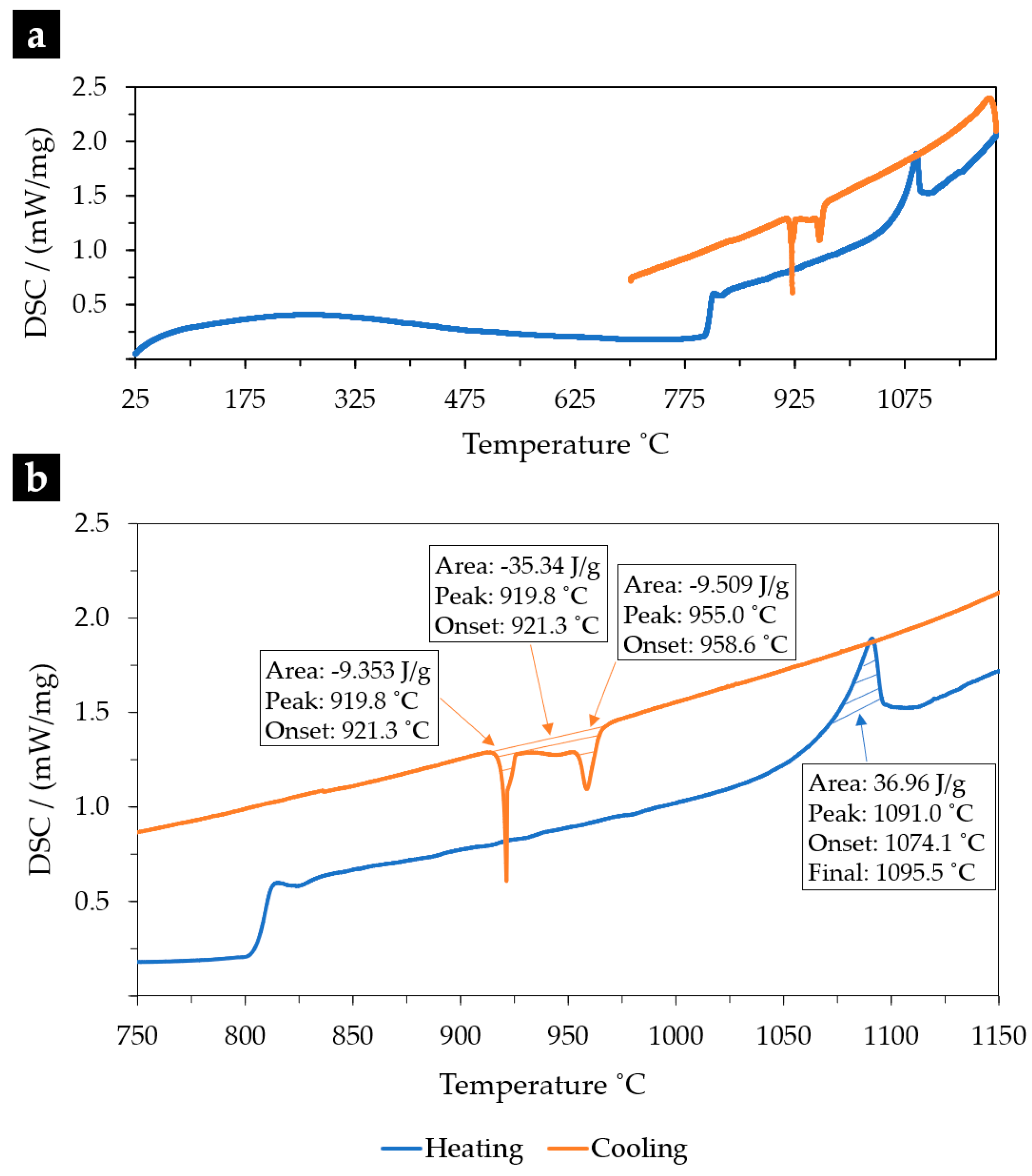
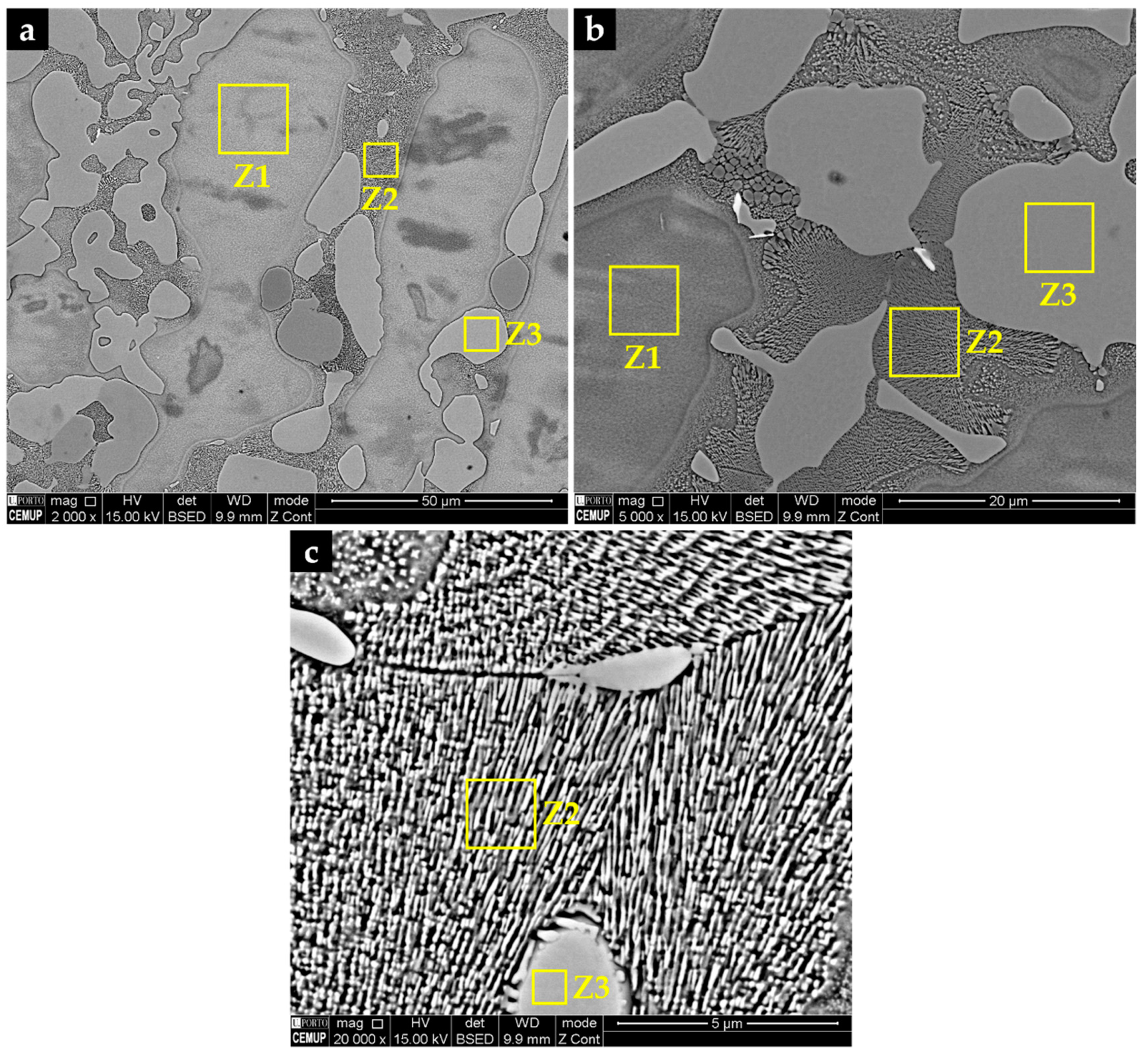

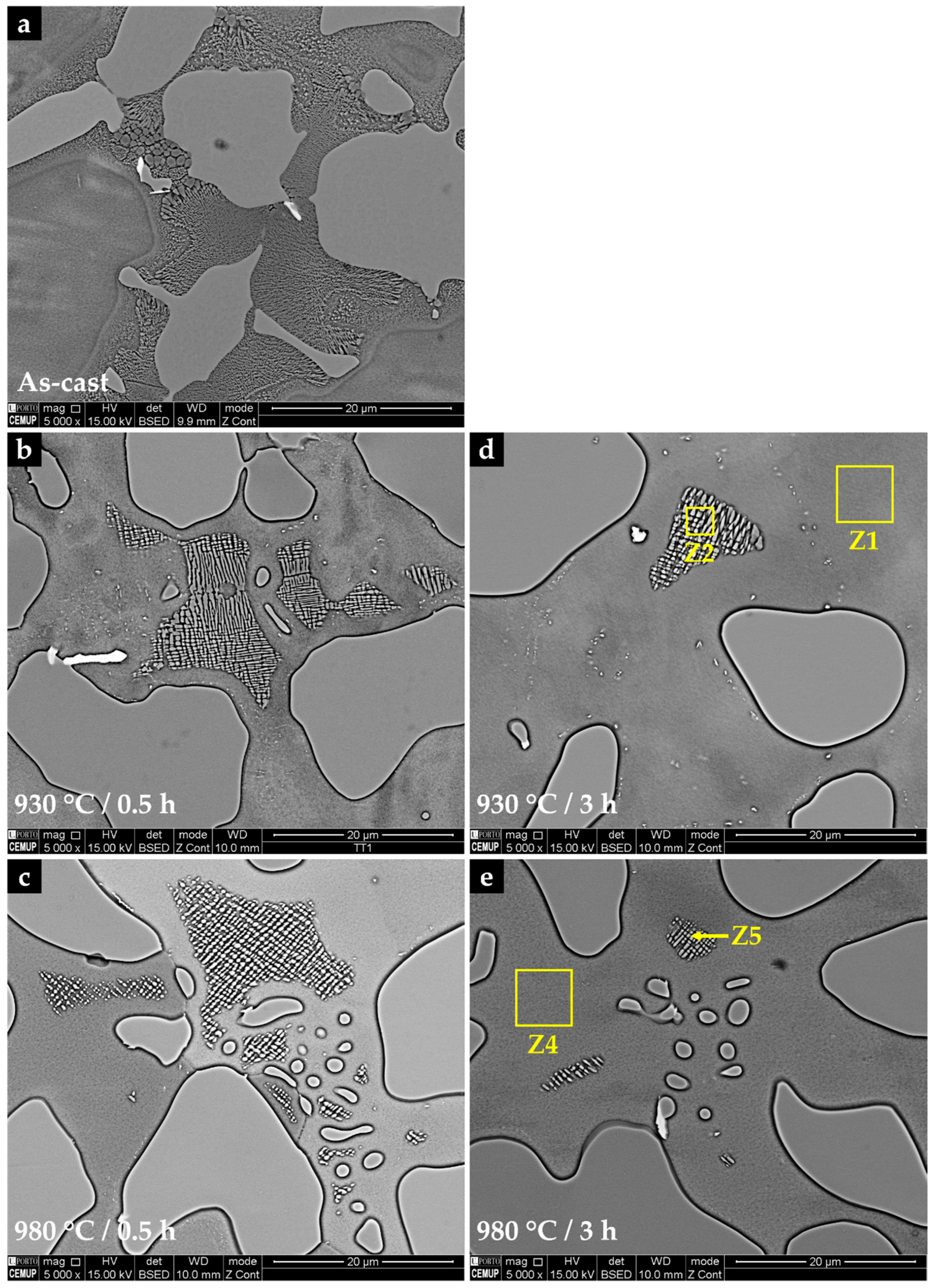
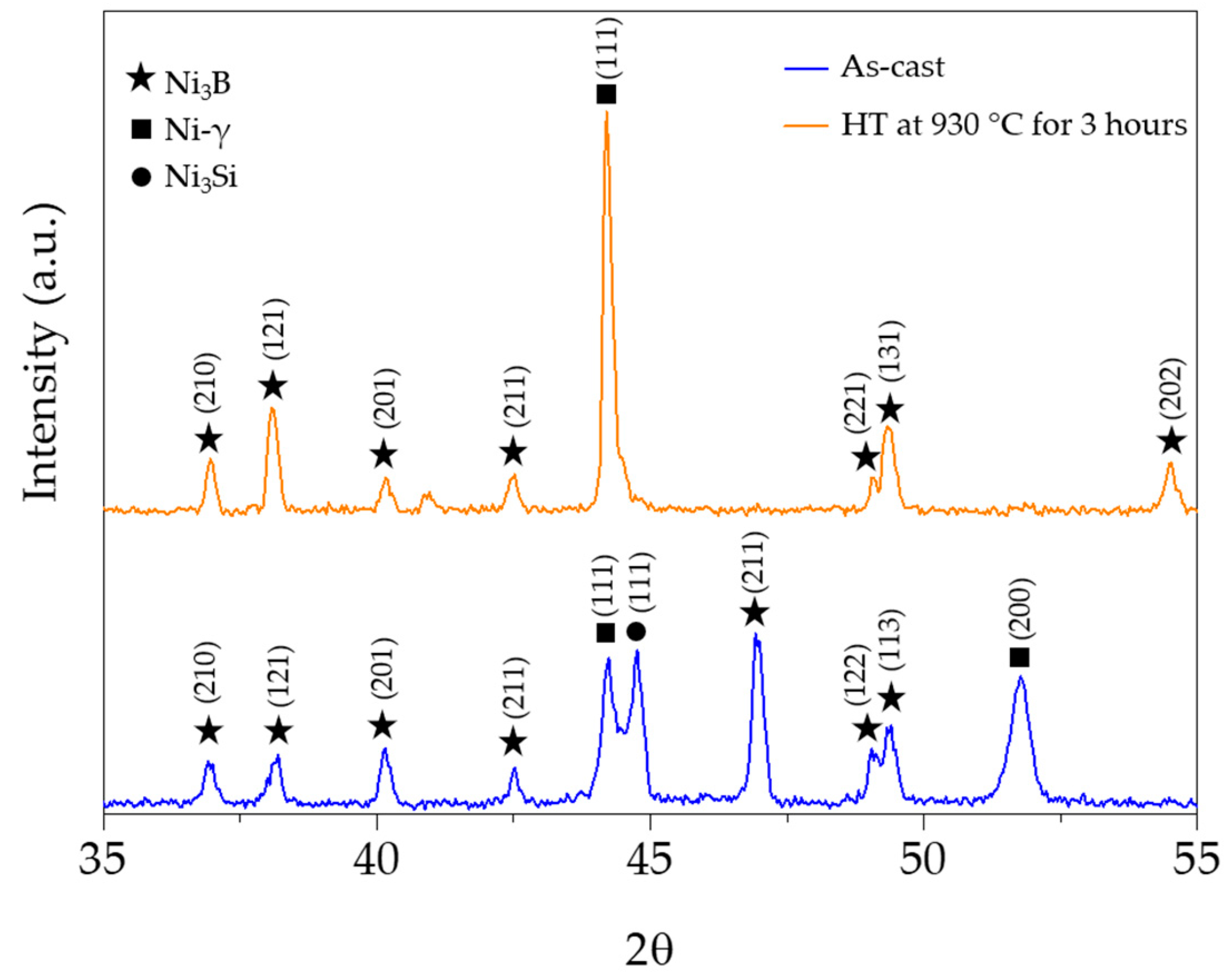
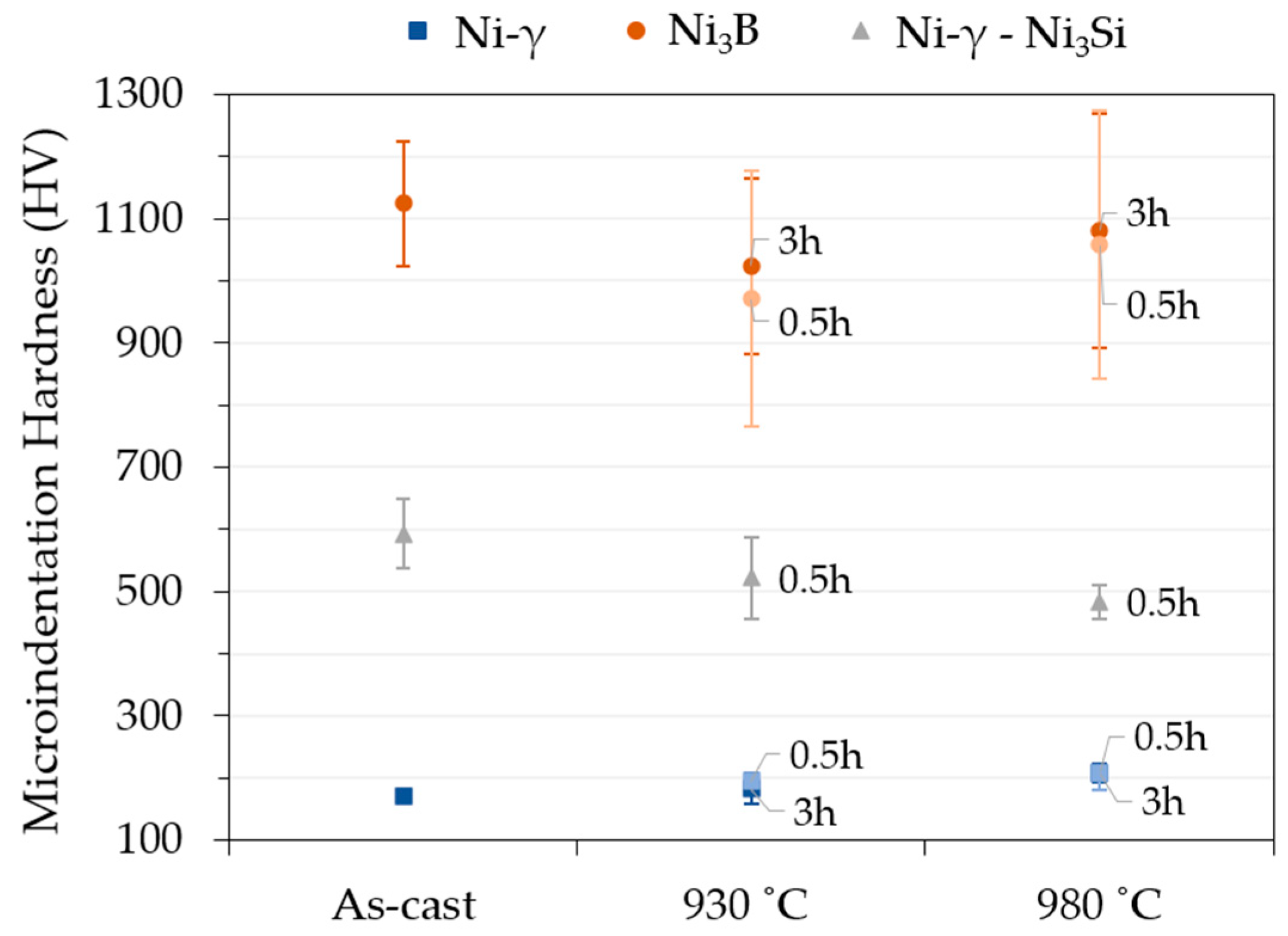
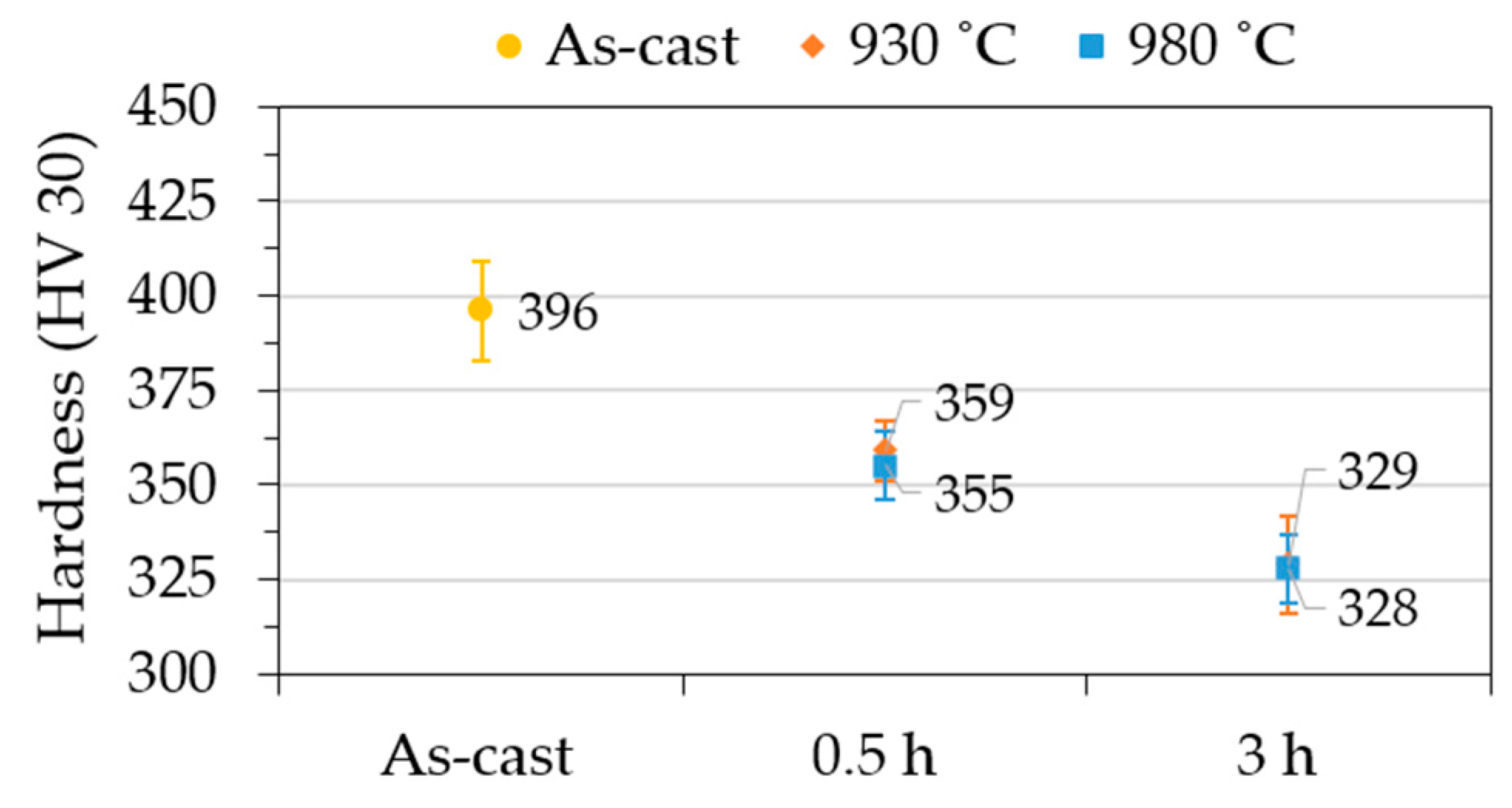
| Ni | Si | B | Cr | Fe | Cu | C |
|---|---|---|---|---|---|---|
| Balance | 3.41 | 2.10 | 0.40 | 0.29 | 0.03 | 0.03 |
| Zone | Chemical Composition (wt.%) | ||||
|---|---|---|---|---|---|
| Ni | Si | Cr | C | Fe | |
| Z1 (Ni-γ) | 92.98 | 3.74 | 1.17 | 1.33 | 0.78 |
| Z2 (Ni-γ-Ni3Si) | 88.73 | 8.66 | 0.66 | 1.39 | 0.56 |
| Heat Treatment | Zone | Chemical Composition (wt.%) | ||||
|---|---|---|---|---|---|---|
| Ni | Si | Cr | C | Fe | ||
| 930 °C/3 h | Z1 (Ni-γ) | 91.96 | 5.95 | 0.70 | 0.64 | 0.75 |
| Z2 (Ni-γ-Ni3Si) | 89.52 | 8.68 | 0.66 | 0.58 | 0.56 | |
| 980 °C/3 h | Z4 (Ni-γ) | 91.84 | 5.78 | 0.90 | 0.62 | 0.86 |
| Z5 (Ni-γ-Ni3Si) | 88.70 | 9.29 | 0.39 | 0.74 | 0.88 | |
Publisher’s Note: MDPI stays neutral with regard to jurisdictional claims in published maps and institutional affiliations. |
© 2021 by the authors. Licensee MDPI, Basel, Switzerland. This article is an open access article distributed under the terms and conditions of the Creative Commons Attribution (CC BY) license (http://creativecommons.org/licenses/by/4.0/).
Share and Cite
Gorito, G.M.; Moreira, A.B.; Lacerda, P.; Vieira, M.F.; Ribeiro, L.M.M. Effect of Heat Treatment on the As-Cast Microstructure and Hardness of NiSi3B2 Alloy. Metals 2021, 11, 539. https://doi.org/10.3390/met11040539
Gorito GM, Moreira AB, Lacerda P, Vieira MF, Ribeiro LMM. Effect of Heat Treatment on the As-Cast Microstructure and Hardness of NiSi3B2 Alloy. Metals. 2021; 11(4):539. https://doi.org/10.3390/met11040539
Chicago/Turabian StyleGorito, Gonçalo M., Aida B. Moreira, Pedro Lacerda, Manuel F. Vieira, and Laura M. M. Ribeiro. 2021. "Effect of Heat Treatment on the As-Cast Microstructure and Hardness of NiSi3B2 Alloy" Metals 11, no. 4: 539. https://doi.org/10.3390/met11040539
APA StyleGorito, G. M., Moreira, A. B., Lacerda, P., Vieira, M. F., & Ribeiro, L. M. M. (2021). Effect of Heat Treatment on the As-Cast Microstructure and Hardness of NiSi3B2 Alloy. Metals, 11(4), 539. https://doi.org/10.3390/met11040539









